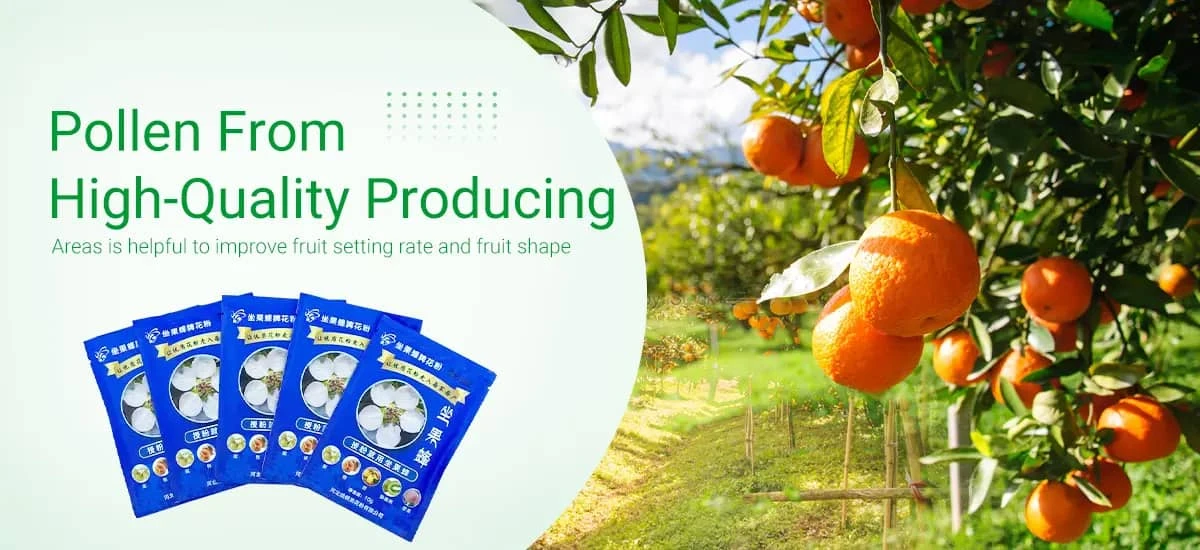අගෝ. . 22, 2025 17:02 ලැයිස්තුවට ආපසු
Understanding Pollen Seasonal Patterns
The study of pollen seasonal patterns is fundamental to successful orchard management, as these natural cycles directly impact fruit production. By tracking when different types of pollen become available throughout the year, growers can implement strategic pollen block techniques to ensure consistent pollination. These three key aspects - understanding natural pollen release, utilizing preservation methods, and recognizing variations among species - form the cornerstone of modern orchard pollination strategies.
Pollen and Its Seasonal Variations
- Pollen availability follows distinct seasonal patterns for each fruit variety
• Early bloomers like apricots release pollen in cooler temperatures
• Temperature fluctuations can shift traditional pollen release schedules
• Monitoring tools help predict optimal pollination windows
• Climate adaptation requires understanding changing pollen cycles
Pollen Block Technology Applications
- Pollen block methods preserve viability during unfavorable conditions
• These techniques allow extension of the natural pollen availability period
• Proper storage maintains germination rates for delayed use
• Enables precise timing of pollination applications
• Particularly valuable for orchards with limited pollinator activity
Different Pollen Types and Their Characteristics
- Different types of pollen exhibit unique seasonal behaviors
• Stone fruits like cherries have brief but critical release periods
• Apple varieties show varied compatibility and timing requirements
• New cultivars are being developed with improved pollen traits
• Research continues to expand knowledge of niche varieties
Pollen FAQs
Q: How does a pollen block work differently for different types of pollen?
A: A pollen block typically creates a physical or chemical barrier on surfaces (like skin or nasal passages) to trap or repel pollen. Its effectiveness varies by different types of pollen due to size and structure: grass pollen, small and lightweight, may require a more adhesive formula to stay trapped, while larger tree pollen (e.g., oak) is easier to block with physical barriers. Some blocks are formulated with anti-allergenic ingredients targeting specific pollen proteins, making them more effective for high-allergen types like ragweed pollen.
Q: What are the most common different types of pollen that trigger allergies, and how can a pollen block help?
A: The most allergenic different types of pollen include grass (Timothy, Bermuda), trees (oak, birch, cedar), and weeds (ragweed, nettle). A pollen block helps by forming a protective layer: nasal blocks reduce inhalation of airborne grass pollen, while skin blocks prevent tree pollen from sticking to skin and causing contact reactions. Weed pollen, often prevalent in late summer, benefits from long-lasting blocks that withstand outdoor exposure, reducing allergen contact during peak seasons.
Q: Can a pollen block completely eliminate exposure to all different types of pollen?
A: No—pollen block products reduce exposure but don’t fully eliminate it, especially for highly airborne different types of pollen. Grass and weed pollen are lightweight and can travel long distances, slipping through barriers if applied unevenly. Tree pollen, larger and heavier, is easier to block, but wind or physical activity can dislodge the barrier. For best results, pair blocks with other measures like air purifiers and avoiding peak pollen times, especially for severe allergies to multiple pollen types.
Q: How do seasonal changes affect the effectiveness of a pollen block across different types of pollen?
A: Seasonal shifts bring varying different types of pollen, impacting pollen block performance. Spring tree pollen (e.g., birch) is larger, so blocks with thicker formulas work better. Summer grass pollen, finer and more abundant, requires blocks with stronger adhesion to resist sweat or rain. Fall weed pollen (ragweed) thrives in dry conditions, so water-resistant blocks are ideal. Temperature and humidity also play a role—high humidity can weaken some blocks, while dry air may cause them to crack, reducing protection.
Q: Are there natural alternatives to chemical pollen block products that work for different types of pollen?
A: Yes—natural pollen block alternatives include beeswax-based balms, which create a physical barrier effective for tree and grass pollen, and essential oil blends (e.g., eucalyptus, lavender) that may repel certain weed pollens. Saline nasal rinses act as a natural block by flushing pollen from nasal passages, working for most pollen types. However, natural options may have shorter longevity than chemical blocks, requiring more frequent reapplication, especially during high pollen counts with diverse pollen types.
Welcome to Hebei jiamingliang pollen Co., Ltd.—your trusted partner in navigating the world of pollen and allergy management. Whether you’re seeking insights into seasonal pollen patterns, effective pollen block solutions, or clarity on different types of pollen, we’re here to empower you with knowledge and tools for a more comfortable life.
At JML Pollen, we understand the challenges of pollen allergies, which is why we focus on delivering reliable resources and products tailored to your needs. Our expertise spans identifying different types of pollen—from tree and grass to weed varieties—so you can better understand your triggers. We also offer high-quality pollen block solutions designed to create protective barriers, reducing exposure to airborne allergens across all pollen types.
Backed by a commitment to accuracy and effectiveness, we curate information and products that stand up to real-world needs. Whether you’re tracking seasonal pollen peaks, seeking natural or chemical pollen block options, or learning to differentiate between allergenic pollen types, our platform provides clear, actionable guidance.
Join our community of allergy sufferers and enthusiasts. Explore our resources, discover trusted solutions, and take control of your pollen-related challenges. Welcome to a space where knowledge meets relief—only at www.jmlpollen.com
